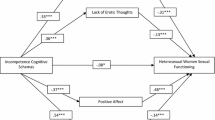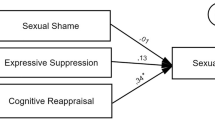Abstract
The study is aimed at investigating the differences between individuals with and without sexual dysfunction on the automatic thoughts content (reported as usually presented) during sexual activity. A total of 491 individuals (163 women and 232 men without sexual problems and 47 women and 49 men with a DSM-IV diagnosis of sexual dysfunction) answered the Sexual Modes Questionnaire (SMQ; Nobre and Pinto-Gouveia (J Sex Res 40:368–382, 2003). Results indicated that men and women with sexual dysfunction reported having had significantly more negative thoughts during sexual activity compared to sexually healthy individuals. Failure and disengagement thoughts (I’m not satisfying my partner, I’m not getting turned on, when will this be over?), sexual abuse thoughts (this is disgusting, he only wants to satisfy himself), and lack of erotic thoughts were significantly more common in women with sexual dysfunction compared to sexually healthy women. Additionally, men with sexual dysfunction presented significantly higher scores on erection concern thoughts (I must be able to have intercourse, I must achieve an erection), failure anticipation thoughts (this is not going anywhere, I’m condemned to failure), and lack of erotic thoughts compared to men without sexual dysfunction. Overall, findings support clinical observations and experimental findings, indicating that cognitive distraction from erotic cues is strongly associated with sexual dysfunction. The increased use of cognitive techniques on the treatment of sexual dysfunction is a major implication of the study.
Similar content being viewed by others
Notes
In order to control the effect of the variables: age, marital status and educational level, the discriminant analysis was performed using a sample constituted by the female clinical group (n = 47) and a sub-sample of the control group (n = 53) matched for age [clinical group (M = 28.66), control group (M = 28.87), t(98) = −0.13, p = .90], marital status [χ 2(4) = 2.53, p = .64] and educational level [Mann–Whitney test for the comparison of the mean orders of the clinical (49.19) and control group (51.66), z = −.44, p = .66].
In order to control the effect of the variables: age, marital status and educational level the discriminant analysis was performed using a sample constituted by the male clinical group (n = 49) and a sub-sample of the control group (n = 50) matched for age [clinical group (M = 42.98), control group (M = 42.46), t(93) = 0.18, p = .86], marital status [χ 2(3) = 5.13, p = .16] and educational level [Mann–Whitney test for the comparison of the mean orders of the clinical (49.15) and control group (50.83), z = −.30, p = .76].
References
Abrahamson, D. J., Barlow, D. H., & Abrahamson, L. S. (1989). Differential effects of performance demand and distraction on sexually functional and dysfunctional males. Journal of Abnormal Psychology, 98, 241–247.
Abrahamson, D. J., Barlow, D. H., Sakheim, D. K., Beck, J. G., & Athanasiou, R. (1985). Effect of distraction on sexual responding in functional and dysfunctional men. Behavior Therapy, 16, 503–515.
Adams, A. E., Haynes, S. N., & Brayer, M. A. (1985). Cognitive distraction in female sexual arousal. Psychohysiology, 22, 689–696.
American Psychiatric Association. (1994). Diagnostic and statistical manual of mental disorders (4th ed.). Washington, DC: Author.
Barlow, D. H. (1986). Causes of sexual dysfunction: The role of anxiety and cognitive interference. Journal of Consulting and Clinical Psychology, 54, 140–148.
Beck, A. T. (1967). Depression: Causes and treatment. Philadelphia: University of Pennsylvania Press.
Beck, A. T. (1996). Beyond belief: A theory of modes, personality, and psychopathology. In P. Salkovskis (Ed.), Frontiers of cognitive therapy. New York: Guilford Press.
Beck, J. S. (1995). Cognitive therapy: Basics and beyond. New York: Guilford Press.
Beck, J. G., Barlow, D. H., Sakheim, D. K., & Abrahamson, D. J. (1987). Shock threat and sexual arousal: The role of selective attention, thought content, and affective states. Psychophysiology, 24, 165–172.
Cappelleri, J. C., Rosen, R. C., Smith, M. D., Mishra, A., & Osterloh, I. H. (1999). Diagnostic evaluation of the erectile function domain of the International Index of Erectile Function. Urology, 54, 346–351.
Carey, M. P., Wincze, J. P., & Meisler, A. W. (1993). Sexual dysfunction: Male erectile disorder. In D. H. Barlow (Eds.), Clinical handbook of psychological disorders: A step by step treatment manual (2nd ed., pp. 442–480). New York: Guilford Press.
Dove, N. L., & Weiderman, M. W. (2000). Cognitive distraction and women’s sexual functioning. Journal of Sex and Marital Therapy, 26, 67–78.
Elliot, A. N., & O’Donohue, W. T. (1997). The effects of anxiety and distraction on sexual arousal in a nonclinical sample of heterosexual women. Archives of Sexual Behavior, 26, 607–624.
Farkas, G. M., Sine, L. F., & Evans, I. M. (1979). The effects of distraction, performance demand, stimulus explicitness, and personality on objective and subjective measures of male sexual arousal. Behaviour Research and Therapy, 17, 25–32.
Geer, J. H., Fuhr, R. (1976). Cognitive factors in sexual arousal: The role of distraction. Journal of Consulting and Clinical Psychology, 4, 238–243.
Hawton, K. (1985). Sex therapy: A pratical guide. Northvale, NJ: Aronson.
Hawton, K. (1989). Sexual dysfunctions. In K. Hawton, P. M. Salkovskis, J. Kirk, & D. M. Clark (Eds.), Cognitive behaviour therapy for psychiatric problems: A pratical guide. Oxford: Oxford University Press.
Nobre, P. J. (2003). Sexual dysfunction: contributions for the construction of a comprehensive model based on cognitive theory. Unpublished doctoral dissertation. Faculdade de Psicologia e Ciências da Educação da Universidade de Coimbra, Coimbra, Portugal.
Nobre, P. J. (in press). Determinants of sexual dysfunction: A cognitive-emotional model. Sexual and Relationship Therapy.
Nobre, P. J., & Pinto-Gouveia, J. (2003). Sexual modes questionnaire: Measure to assess the interaction between cognitions, emotions and sexual response. Journal of Sex Research, 40, 368–382.
Nobre, P. J., & Pinto-Gouveia, J. (2006). Dysfunctional sexual beliefs as vulnerability factors to sexual dysfunction. Journal of Sex Research, 43, 68–75.
Nobre, P. J., & Pinto-Gouveia, J. (2007). Cognitive schemas activated in negative sexual events and sexual dysfunction. Manuscript submitted for publication.
Nobre, P. J., & Pinto-Gouveia, J. (in press). Cognitions, emotions and sexual response: Analysis of the interaction between automatic thoughts and emotional responses during sexual activity and its impact on sexual arousal. Journal of Sex Research.
Nobre, P. J., Pinto-Gouveia, J., & Gomes, F. A. (2003). Sexual dysfunctional beliefs questionnaire: An instrument to assess sexual dysfunctional beliefs as vulnerability factors to sexual problems. Sexual and Relationship Therapy, 18, 101–135.
Rosen, R. C., Brown, C., Heiman, J., Leiblum, S., Meston, C., Shabsig, R. et al. (2000). The Female Sexual Function Index (FSFI): A multidimensional self-report instrument for the assessment of female sexual function. Journal of Sex and Marital Therapy, 26, 191–208.
Rosen, R. C., Leiblum, S. R., & Spector, I. (1994). Psychologically based treatment for male erectile disorder: A cognitive-interpersonal model. Journal of Sex and Marital Therapy, 20, 67–85.
Rosen, R. C., Riley, A., Wagner, G., Osterloh, I. H., Kirkpatrck, J., & Mishra, A. (1997). The International Index of Erectile Function (IIEF): A multidimensional scale for assessment of erectile dysfunction. Urology, 49, 822–830.
Viglietta, M. B. (1982). The effects of anxiety versus distraction on sexual arousal in males. Unpublished doctoral dissertation, State University of New York at Albany, Albany, New York.
Wincze, J. P., & Barlow, D. H. (1997). Enhancing sexuality: A problem solving approach (therapist guide). Albany, NY: Graywind.
Zilbergeld, B. (1999). The new male sexuality (rev. ed.). New York: Bantam.
Author information
Authors and Affiliations
Corresponding author
Rights and permissions
About this article
Cite this article
Nobre, P.J., Pinto-Gouveia, J. Differences in Automatic Thoughts Presented During Sexual Activity Between Sexually Functional and Dysfunctional Men and Women. Cogn Ther Res 32, 37–49 (2008). https://doi.org/10.1007/s10608-007-9165-7
Received:
Accepted:
Published:
Issue Date:
DOI: https://doi.org/10.1007/s10608-007-9165-7




